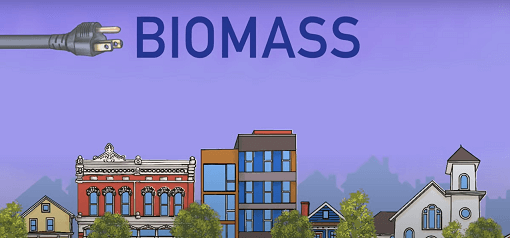Best Biomass is a form of renewable energy generated by using organic matter as a source of fuel. Biomass

It is the oldest form of renewable energy, with a history dating back to the use of wood and other organic materials to power steam engines in the 19th century.
In recent years, biomass has become a popular form of renewable energy due to its sustainability and potential to reduce carbon emissions.
important BIOMASS ?
One important point to consider about biomass is its potential role in mitigating climate change.
By using biomass as a source of energy, it is possible to reduce greenhouse gas emissions and replace fossil fuels, which are a major contributor to climate change.
However, it is important to note that not all biomass is created equal in terms of its environmental impact. Biomass that comes from sustainable sources, such as wood waste or agricultural residues, can provide significant environmental benefits.
But if biomass is sourced from unsustainable or non-renewable sources, such as clearing forests or using crops that compete with food production, it can actually contribute to environmental harm and undrmine the goal of reducing greenhouse gas emisions.
Additionally, the efficiency and sustainability of biomass energy systems can vary widely depending on the technology used, the scale of the operation, and other factors. It is important to carefully consider these factors and ensure that biomass energy systems are designed and operated in a way that maximizes their potential benefits and minimizes their environmental impact.
Biomass can be used to generate electricity, to provide heat and power in buildings, to produce liquid biofuels, and to produce chemicals, building materials, and other industrial products.
In addition, biomass can be utilized for the production of biogas, which can be used for both electricity generation and vehicle fuels.
production and utilization. On the production side, the focus should be on developing technologies to increase the efficiency of biomass-to-energy conversions, such as gasification and pyrolysis.
On the utilization side, the focus should be on the development of technologies to efficiently convert the produced energy into useful electricity, heat, or biofuels.
Research and development of new technologies is essential for the successful implementation of biomass as a renewable energy source.
For this, governments and private companies must invest in research and development of new technologies, and support incentives to promote the implementation of biomass-based energy projects.
Furthermore, public education and awareness campaigns are needed to ensure the successful deployment of biomass-based energy projects.
Q: What is biomass?
Biomass refers to any organic material that comes from plants or animals, including wood, crops, and agricultural waste.
Q: How is biomass used?
Biomass can be used for a variety of purposes, including as a fuel for heating and electricity generation, as a feedstock for biofuels, and as a source of chemicals and other products.
Q: Is biomass renewable?
Yes, biomass is considered renewable because it comes from living or recently living organisms, and can be regrown or replaced over time.
Q: What are the environmental benefits of using biomass?
Using biomass as a source of energy can reduce greenhouse gas emissions compared to fossil fuels, as the carbon in biomass is part of a natural carbon cycle rather than adding new carbon to the atmosphere.
Additionally, biomass can provide a way to recycle organic waste and reduce landfill use.
Q: What are the drawbacks of using biomass?
Biomass can have a high cost compared to fossil fuels, and can require significant amounts of land and water to produce.
There can also be concerns about the sustainability and environmental impacts of harvesting and transporting biomass, particularly if it involves deforestation or other land-use changes.
Q: What is the future of biomass?
Biomass is expected to play a role in the transition to a more sustainable, low-carbon economy, particularly in sectors such as transportation and heating where electrification may be challenging.
However, there will likely be ongoing debates about the environmental and social impacts of using biomass and how to ensure its sustainability.
- Overview of biomass and its uses
- Benefits of biomass production
Types of Biomass
- Wood and wood waste
- Agricultural waste
- Animal waste
- Algae
- Food waste
Advantages of Biomass
- Renewable energy source
- Low emissions
- Diversified use
- Cost-effective
Disadvantages of Biomass
- Depletion of land
- Contamination of land
- High maintenance costs
Conclusion
- Overview of biomass and its uses
- Advantages and disadvantages of biomass
- Potential applications of biomass
- Future outlook of biomass
- Advantages and disadvantages of biomass
Advantages,
Biomass is a renewable energy source, meaning it will not run out as long as plants and other organic material continue to grow.
It is considered a low-carbon energy source, producing fewer emissions than fossil fuels.
Wood and wood waste?

Wood and wood waste are renewable energy sources that have been utilized for many centuries.
Wood is a naturally occurring material that can be burned to generate heat, while wood waste can be processed into pellets or briquettes for the same purpose. Wood and wood waste have a relatively low carbon footprint compared to other energy sources, making them an attractive option for those looking to reduce their energy consumption.
Disadvantages,
Burning biomass releases pollutants like sulfur dioxide, nitrogen oxide, and other hazardous materials.
There is potential for large-scale biomass operations to cause resource depletion, biodiversity loss, soil erosion, and displacement of local communities.
Potential contributions to climate change from carbon dioxide emissions from burning biomass, as well as land-use changes for growing feedstocks.
Future outlook of biomass
The future outlook of biomass is promising, as it is regarded as a key component in achieving both global energy security and a more sustainable energy system.
It has the potential to reduce greenhouse gas emissions and dependence on foreign oil, and offers a more cost-effective alternative to fossil fuels.
The International Energy Agency predicts that the use of biomass will increase by up to 800% by 2040, driven by technological advances and increased demand for renewable electricity and heat.
In addition, biomass is also being used to create new products, such as bio-based plastics and bioplastics, which are an alternative to traditional plastics.
With the growing demand for renewable energy sources, the outlook for biomass is highly positive.
Biomass is an increasingly important source of renewable energy, with the potential to drastically reduce humanity’s emissions that contribute to climate change.
In this blog post, we will explore what biomass is and how it can be used to generate renewable energy. We’ll also look at the various techniques used to harness this energy, discuss the current state of the technology, and explore the future of biomass energy.
Finally, we’ll highlight some of the challenges that biomass energy faces and the ways in which they can be addressed.
Advantages of Biomass Renewable energy source
Biomass is a renewable energy source, meaning it won’t run out like fossil fuels. This is one of the biggest advantages of biomass energy.
It’s a reliable energy source that can be produced at any time. Additionally, biomass is abundant; it can be found nearly everywhere on the planet.
This means it won’t have the issue of limited availability, like traditional fossil fuels do.
Biomass Low emissions
Biomass is a renewable energy source that has the potential to reduce greenhouse gas emissions.
It is derived from organic materials like plants, crops, and forest residues, and is typically burned to generate electricity.
The use of biomass has the potential to reduce emissions compared to non-renewable energy sources like coal, oil, and natural gas.
Biomass energy is considered carbon-neutral because it does not add additional carbon dioxide to the atmosphere.
When biomass is burned for energy, the carbon dioxide released is offset by the amount of carbon dioxide that was taken in during the plant’s growth.
This means that biomass energy is considered to be a low-emission energy source.
Biomass energy can also be used to produce biofuels, such as ethanol and biodiesel.
These biofuels have the potential to reduce emissions compared to traditional fossil fuels, and can be used in vehicles and other machines that are designed to run on these fuels.
Overall, biomass is a renewable energy source that has the potential to reduce greenhouse gas emissions.
It is considered to be a low-emission energy source and can be used to produce biofuels like ethanol and biodiesel.
Utilizing biomass could be an important part of a comprehensive approach to reducing emissions and fighting climate change.
Biomass Cost-effective
Biomass energy is becoming increasingly popular throughout the world due to its cost-effectiveness and sustainability.
This form of renewable energy can be produced from organic materials such as wood, waste, and agricultural products.
It is clean and renewable.
Additionally, wood and wood waste can be used to create other products, such as paper or furniture, providing additional economic and environmental benefits.
Thank you for visiting our website! We hope you found what you were looking for and come back again soon,
